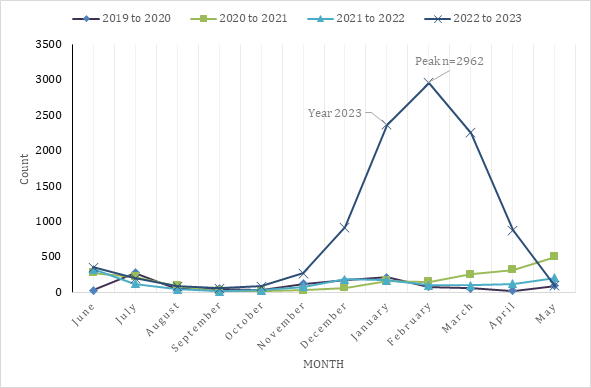Article Info
Year: 2024
Month: January
Issue: 1
Pages: 10
Dengue fever is a viral infection affecting approximately 100 to 400 million people annually1. Saudi Arabia reported the second-highest number of confirmed dengue cases in the WHO Eastern Mediterranean Region in 2023, with most cases occurring in Jeddah during 2021-20222-4.
Our aim is to describe the sociodemographic data of dengue fever increased cases, including age, gender, location, and nationality. Second, to determine whether the surge represents an epidemic. Finally, investigate the possible causes.
We utilized the dengue fever surveillance dataset from the Jeddah Public Health Department, covering 2019 to May 2023. This dataset was checked for duplication, filtered to exclude non-Jeddah residents, and assessed for missing values.
We noticed that on November 24, 2022, unprecedented rainfall in Jeddah occurred late in autumn, after which the number of cases increased markedly during winter.
We found that the dengue fever outbreak in Jeddah, Saudi Arabia, from September 25, 2022, to April 29, 2023, resulted in 9,729 cases over 31 weeks. The most weekly cases occurred during the week of February 5-11, 2023, with 907 cases. Cases began to decline in numbers in late winter and spring. By the week starting from April 30, 2023, the number of cases returned to the expected value of 92, indicating the potential end of the outbreak.
The most affected age group was young adults (18-39 years), representing 55% of cases. Most cases were male (81.4%) and non-Saudi (61.9%). Despite 48% of district locations being unknown, analysis of the reported data showed that most cases were from Central Jeddah (337 cases, 63.8%), followed by Eastern Jeddah (907 cases, 17.9%).
We conclude that effective surveillance and establishing intersectoral plans before the rainy season are crucial for effective vector control. This approach helps prevent outbreaks, particularly in overgrown areas like central and eastern Jeddah. Targeting younger adults and non-Saudi nationals with public health interventions and plans is also necessary.
Figure 1: Cases of Dengue Fever in Jeddah from June 2019 to May 2023, Saudi Arabia

References
1. Centers for Disease Control and Prevention. Transmission | Dengue | CDC [Internet]. [cited 2023 May 5]. Available from: https://www.cdc.gov/dengue/transmission/index.html
2. Ministry of Health. Statistical-Yearbook-2021 [Internet]. Ministry of Health, Saudi Arabia; 2021 [cited 2023 May 6]. 191 p. Available from: https://www.moh.gov.sa/Ministry/Statistics/book/Pages/default.aspx
3. Saudi Ministry of Health. Statistical Yearbook. 2022. 41 p.
4. World Health Organization (WHO). DENGUE GUIDELINES FOR DIAGNOSIS, TREATMENT, PREVENTION AND CONTROL TREATMENT, PREVENTION AND CONTROL TREATMENT, PREVENTION AND CONTROL [Internet]. Available from: www.who.int/tdr
فاشية حمى الضنك بمدينة جدة بالمملكة العربية السعودية (سبتمبر 2022 إلى ابريل 2023)
حمى الضنك هي عدوى فيروسية تؤثر على ما يقرب من 100 إلى 400 مليون شخص سنويًا. حالات حمى الضنك المؤكدة في المملكة العربية السعودية تعد ثاني أعلى دولة في منطقة شرق المتوسط التابعة لمنظمة الصحة العالمية لعام 2023، علما بأن معظم الحالات خلال الفترة 2021-2022 تم تبليغها لوزارة الصحة من مدينة جدة.
هدفنا هو وصف البيانات الاجتماعية والديموغرافية، بما في ذلك العمر، الجنس، والجنسية للحالات التي شهدت زيادة عن المتوقع لحالات حمى الضنك في مدينة جدة، وتحديد ما ان كان هنالك تفشي والأسباب المتوقعة لذلك.
قمنا بتحليل بيانات المراقبة الوبائية لحمى الضنك المرسلة من قبل إدارة الصحة العامة بمدينة جدة للأعوام 2019-2023، وتم تصفية البيانات لاستبعاد حالات من غير المقيمين بمدينة جدة.
علما بأنه في يوم 24 نوفمبر 2022 حدثت أمطار غير مسبوقة في مدينة جدة في اواخر فصل الخريف، تدرجت في الزيادة الى أن بلغ أقصاها في فصل الشتاء.
وجدنا أن تفشي حالات حمى الضنك في مدينة جدة بدأ من 25 سبتمبر 2022 إلى 29 أبريل 2023، حيث بلغ الإجمالي الى 9,729 حالة على مدى 31 أسبوعًا، علما أنه في الأسبوع من 5-11 فبراير 2023 بلغت عدد الحالات 907 و هو العدد الأكبر للبلاغات الأسبوعية، وبعدها لاحظنا تحسن في عدد الحالات أواخر فصل الشتاء و خلال فصل الربيع وبحلول الأسبوع الذي بدأ من 30 أبريل 2023، عاد عدد الحالات إلى القيمة المتوقعة 92، مما أعلن عن نهاية التفشي.
كانت الفئة الأكثر إصابة هي فئة الشباب (18-39 عامًا)، حيث مثلت 55% من الحالات، و معظم الحالات من الذكور (81.4%) و من غير السعوديين (61.9%)، بالرغم من أن 48% من مواقع المناطق لم يتم إبلاغها إلا أن معظم الحالات المبلغة كانت من وسط مدينة جدة (337 حالة، 63.8%)، وشرقها (907 حالة، 17.9%).
نوصي بضرورة وضع الخطط للقضاء على البعوض الناقل للمرض قبل موسم الأمطار بالتعاون مع الجهات المعنية مع الاخذ بعين الاعتبار المناطق التي تشهد الزيادة في وسط وشرق مدينة جدة.